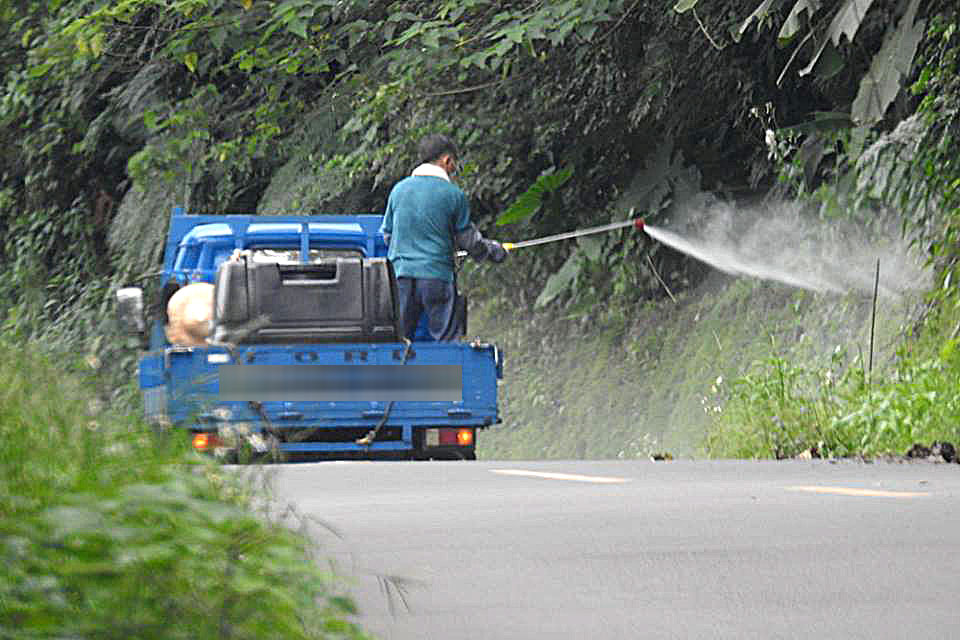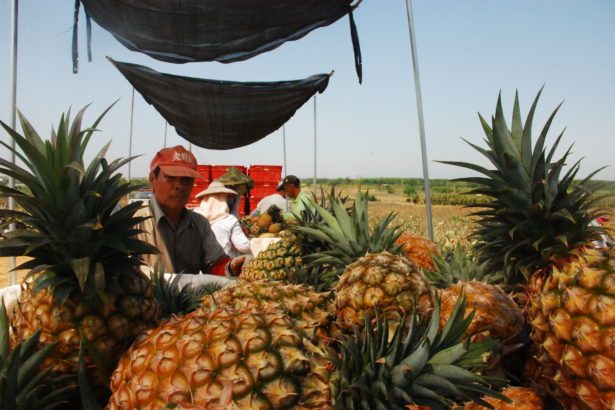Pesticide consumption in Taiwan has reached a 17-year high! The US court ordered Garrette to pay sky-high compensation and ban Taosong for the protection of babies. Will Taiwan follow suit?
Share +1 Tweet Email
Wen/Upstream and downstream reporters Liu Yixin, Cai Jiashan
Monsanto sold the carcinogenic herbicide Carphos, and the San Francisco Supreme Court ruled that it must compensate Dewayne Johnson, a campus administrator who suffered from cancer, for $290 million (about NT$9 billion). In addition, US courts have ordered the ban on "tausson" for fear of damaging the baby's nerves. However, the sales of these two pesticides in Taiwan ranked second and sixth respectively (2016). Is Taiwan exposed to a high-risk environment? Should the pesticide be further regulated or banned?
In addition, China's pesticide use per unit area ranks first in the world. As far as herbicides are concerned, from 2000 to 2014, the average amount of herbicides used per hectare in China was 4.22 kg (calculated by active ingredients), about 3 times that of France and Germany, and 1.5 times that of Holland, Japan and Korea. Even Brazil, the world's second-largest producer of GM crops, uses fewer herbicides per unit area than China. The latest data in 2017 jumped to 5.54 kg per hectare, a record high in nearly 20 years.
The Council of Agriculture launched a 10-year pesticide halving policy, but the total pesticide consumption in China in 2017 totaled 10,549 metric tons, a record high in 17 years and an increase of 1045 metric tons over the previous year. The two pesticides that have recently caused controversy are both used in high quantities in China. According to the statistics of the Bureau of Prevention and Inspection, the consumption of glyphosate in 2017 was 1463.9 metric tons, which is the most used herbicide. 535.1 metric tons of tausone was used, accounting for 19 per cent of all pesticides. (All based on active ingredients)! function(e,t,s,i){var n="InfogramEmbeds",o=e.getElementsByTagName("script"),d=o[0],r=/^http:/.test(e.location)? "http:":"https:";if(/^\/{2}/.test(i)&&(i=r+i),window[n]&&window[n].initialized)window[n].process&&window[n].process();else if(! e.getElementById(s)){var a=e.createElement("script");a.async=1,a.id=s,a.src=i,d.parentNode.insertBefore(a,d)}}(document,0,"infogram-async","//e.infogram.com/js/dist/embed-loader-min.js");
Why does the goal of "pesticide reduction" not advance but retreat? Feng Haidong admitted that this increase is abnormal fluctuation, should be related to last year's Para cut purchase, in addition to last year began to require pesticide production industry, import industry, retail industry to declare to the inspection bureau,"may run out some previously did not declare the amount."
Monsanto verdict is jury decision, not scientific evidence
"At present, all countries in the world believe that there is no cancer risk for glyphosate." Feng Haidong, director of the Bureau of Prevention and Inspection, said that in 2015, the World Health Organization's Agency for Cancer Research (IRAC) adjusted phosphorus to a 2A carcinogen that is likely to cause cancer. At that time, the European Food Safety Agency (EFSA) and the United States Environmental Protection Agency (EPA) restarted the assessment, but the assessment organizations of various countries believed that there was no carcinogenic risk.
Feng pointed out that the IRAC presented scientific evidence to conclude that glyphosate may cause cancer, but the evidence was insufficient. "Everyone has misunderstood the results of the study. The evidence now is only that it is likely to cause cancer, not confirmed." He argued that Monsanto's verdict was a joint decision by a jury and not scientific evidence that glyphosate caused cancer.
Feng pointed out that in the food safety section, glyphosate is a systematic drug, farmers for harvest, use very carefully, will not be directly used on crops. However, in the 373 items of pesticide residues in food announced by our country, the multiple residue analysis method does not contain glyphosate. How can we know whether there is no residue? Feng said that although this method does not include glyphosate, there are still individual methods to detect its residues, and the sampling results at present meet the standards.
Does the product contain a warning? FDA: If it is determined that cancer is caused, it is not allowed to sell
Feng Haidong said that the Monsanto case is the risk of user exposure to pesticides, not food safety, so the FDA will re-evaluate the exposure of Taiwanese users. From the standpoint of protecting farmers, risks will be raised when they are discovered, but they may not necessarily be banned. Protective measures can be used to achieve this. As for whether it is possible to label carcinogenic warnings on products in the future? Feng responded that if it was determined that the pesticide would cause cancer, it would not be registered or sold at all.
Drug Poison Institute: Consumers should have no exposure risk, farmers and workers need further research and evaluation
"In the first half of the year, the evaluation of Jiapo was started. The resolution considered that the risk of exposure to consumers was low, but it would be continuously monitored and evaluated." Fei Wen-chi, director of the Institute of Agricultural Drug Toxicology, explains that whether a drug is banned must be evaluated according to its toxicity, the country in which it is used, and the risks of exposure. In terms of toxicology, the World Health Organization Cancer Research Center found that glyphosate can cause cancer in animals, but at least two kinds of animals must be proved to be carcinogenic, and animals and humans have differences. Countries have initiated assessments, but no further control has been made.
Vivien explained that in the United States, as a result of planting GM crops, carbophos will be widely sprayed on crops. However, Taiwan does not grow GM crops and does not spray them directly on crops. Farmers are also very careful to avoid affecting crops.
In terms of exposure risk, Fei Wenqi further pointed out that the assessment results confirmed that consumers had no exposure risk, and further research was needed for farmers and pesticide factory workers exposed to large amounts of phosphorus, which was currently under way.


Hawaiian residents jointly demanded that Tausong not be used near schools (Photo source: https://bit.ly/2MKfANx)
Feng Haidong: Both Tausong and Jialin Sai have been included in the evaluation list
Feng Haidong pointed out that both Tausong and Jiapusai have been included in the assessment list. Tausong is a high dosage and high risk, while Jiapusai is a high dosage. Control measures will not be announced until the assessment is completed.
Regarding the management mechanism of high-risk pesticides, Feng said that in addition to finding alternative drugs, the overall system will increase the difficulty of purchasing high-risk pesticides, which may limit the availability of drugs with prescription labels, or must be purchased by professional spray agents with certain protective measures.
The relatively safe pesticides are cheaper and more convenient to buy, and subsidies are given to biological pesticides to create incentives; in addition, the concept of integrated drug management should be promoted, and chemicals should not be over-reliant.
Total pesticide consumption hit a 17-year high, caused by Paraquat rush purchase and truthful declaration
The Council of Agriculture launched a 10-year pesticide halving policy, but in 2017, China's total pesticide consumption totaled 10,549 metric tons, a new high since 2000 and an increase of 1045 metric tons over the previous year.
Why does the goal of "pesticide reduction" not advance but retreat? Feng Haidong said frankly, this increase is abnormal fluctuation, should be related to last year's Barakar competition, because Barakar is about to be banned, many farmers rush to buy goods, about the usual two years of sales.
However, in addition to herbicides, pesticides and fungicides are also used more than the previous year by 300 to 400 tons, Feng Haidong explained, because last year began to require pesticide production, import industry, retail industry to make electronic declaration, there is no way to avoid,"may come out some previously did not truthfully declare the amount," future statistics will be closer to the true situation.
The Pesticide Division of the Bureau of Prevention and Inspection explained that in the past, the pesticide industry reported the figures to the Association in good conscience. Last year, it began to require reporting to the Bureau of Prevention and Inspection, and it will be checked upstream and downstream. Therefore, the consumption figures seem to have increased. In January this year, electronic reporting was promoted. In the future, the industry will have to report truthfully.
Not a single plant remains-excessive herbicide impacts soil ecology and increases cancer
California Resolves Herbicides Must Be Labeled to Contain Carcinogens in Spring, Millions of People in Europe Sign Anti-Gaphos
Is it possible to halve pesticides in ten years? Feng Haidong, the new director of the Bureau of Prevention and Inspection: To change farmers 'hearts
Share +1 Tweet Email
- Prev

New Milestones of Industry-University Cooperation in Tainan Create a New Generation of AI Agricultural Photoelectricity
"2018 International Symposium on Smart Photoelectric Agricultural Robots and Signing Ceremony of Memorandum of Cooperation between Zhiyuan Foundation and Jiaotong University" was held yesterday (13) morning at the Advantech International Conference Hall of Tainan Branch of Jiaotong University. Mayor Li Mengyan was invited to attend.
- Next

The raw materials of agro-processed products inject new life into the original character IP in Taiwan!
The raw materials of agro-processed products inject new life into the original character IP in Taiwan!
Related
- A course of planting techniques and methods on how to grow carrots
- How to plant the latest tulips?
- Is it better to pick tea in the morning or in the afternoon? When is the best time for tea to be picked? what is the third or fifth tea?
- Launch Yuanxiao Happy combination Haocha + Tea Yuan healthy Taste
- Penghu Tourism "Fireworks 20 Parade with You"
- 2022 West Lake Happiness holds "Digital Revitalization Voucher" and draws iphone13 and laptop.
- Banqiao Fuzhou social houses are designed to change start-up combined with police elimination to create a safe and livable environment
- The convenient measure of "mechanical weeding" in Xinbei has been abused and the Agriculture Bureau has imposed heavy penalties on the illegal land consolidation.
- Changgeng University Joins Hands with Four Memory Factories to Rescue Memory Talent Shortage
- The list of Taiwan's top 100 MVP managers is listed by the Director-General of the Farmers' Association of Sanxia District.

